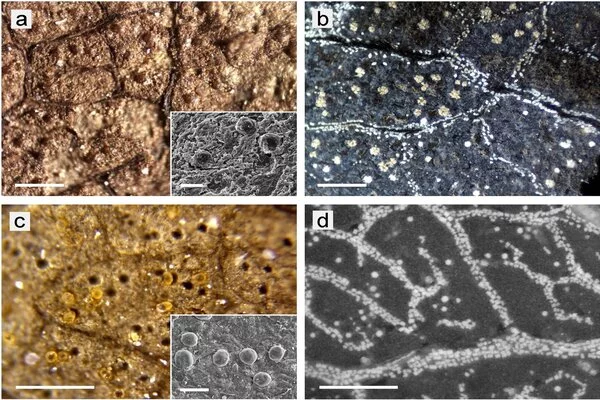Fossils are the natural processes that preserved the remains or traces of ancient life. Shells, bones, stone imprints of animals or microbes, exoskeletons, objects preserved in amber, petrified wood, coal, hair, oil, and DNA remnants are examples of fossils.
Under the microscope, puzzling structures in fossil leaves are frequently visible. For the first time, researchers have demonstrated that they are formed from calcium oxalate crystals. On the one hand, their discovery makes it easier to identify the ancient plant remains. However, it also explains how the ability to form such crystals arose and what function they presumably serve.
Ro-59.9, a fossil specimen, is riddled with microscopic cavities. Some of them appear to have tiny raspberries slumbering inside them, each measuring only two hundredths of a millimeter in size. The fossilized leaf is more than 20 million years old and comes from the Rott fossil site near Bonn. It is currently impossible to say which plant species it belongs to.
Perhaps that will change soon. Because the position and shape of the cavities are like a kind of fingerprint: they can be used to identify fossil plant remains. “Until now, it was not known how these cavities were formed,” explains Mahdieh Malekhosseini from the Institute of Geosciences at the University of Bonn. “For example, it was believed that they came from algae or pollen from other plants that somehow got onto the leaf during fossilization. But after analyzing hundreds of these structures, we can rule that out. Instead, we were able to show that calcium oxalate crystals are responsible for the depressions.”
We studied the microstructure of the pits and their distribution on fossil leaves of known species. We also looked at calcium oxalate crystals in the leaves of modern plants. We discovered striking parallels in closely related species. For example, the crystal imprints in a fossil ginkgo leaf strongly resemble the calcium oxalate deposits of a present-day ginkgo in distribution and structure.
Mahdieh Malekhosseini
Microlenses for better photosynthesis?
Calcium oxalate (CaOx) is one of the most common bio-mineral in extant plants and is believed to serve a variety of functions such as calcium storage and herbivore defense. However, traces of CaOx crystals have rarely been identified in fossil plants, and they are primarily known from fossil gymnosperms, where empty cavities of former CaOx crystals or ghost crystals have been reported from leaf cuticles of some Late Cretaceous and Cenozoic conifers.
Many living plants produce calcium oxalate, making it one of the most common biominerals. Its functions have yet to be definitively defined. However, it is believed that the crystals serve as calcium stores. Furthermore, because they form in the leaf but frequently penetrate the leaf surface as they grow, they are likely to repel pests. “Many insects have an aversion to calcium oxalate — they don’t like to walk on it,” explains Prof. Dr. Jes Rust, who oversaw the study. “Some plants appear to use the crystals as microlenses to use sunlight more efficiently for photosynthesis.”

The crystals are extremely acid sensitive. As a result, they dissolve during fossilization and are no longer detectable in millions of year old finds. Imprints, on the other hand, frequently remain in the places where they have sat (in biology one speaks of “druses”). Organic material or other minerals can sometimes accumulate in these depressions, which then sit like tiny beads in the fossil leaf.
“We studied the microstructure of the pits and their distribution on fossil leaves of known species,” Malekhosseini says. “We also looked at calcium oxalate crystals in the leaves of modern plants.” We discovered striking parallels in closely related species. For example, the crystal imprints in a fossil ginkgo leaf strongly resemble the calcium oxalate deposits of a present-day ginkgo in distribution and structure.”
Important insights into evolution
It was already known that fossils of bare-seeded plants like firs and pines occasionally show imprints of calcium oxalate crystals. This was not known about angiosperms, which include most flowers and deciduous trees.
“This is a completely new field of research,” Jes Rust explains. “Among other things, we now want to investigate how the ability to form calcium oxalate crystals has evolved over the course of evolution. To do so, the researchers want to focus on times when environmental conditions changed quickly, such as temperature or UV radiation intensity. “If the distribution of the drusen changes after such incisions, we can draw conclusions about the crystals’ biological function,” says Rust.
















